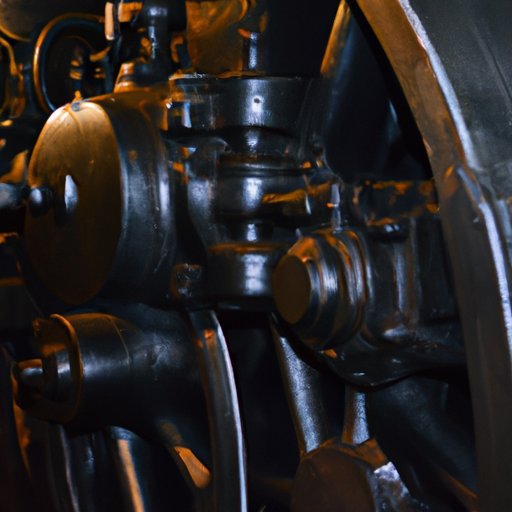Introduction
A steam locomotive is a railway vehicle that produces its power through a steam engine. This type of locomotive was widely used during the 19th century and early 20th century for passenger and freight trains. Despite its popularity, the steam locomotive has been replaced by diesel and electric locomotives due to their increased efficiency and lower costs. Nevertheless, steam locomotives remain an important part of the railroad industry and continue to be used for special occasions and tourist attractions. In this article, we will explore how a steam locomotive works, from the science behind its power to the historical and engineering elements involved.
Exploring the Mechanics of a Steam Locomotive
The power of a steam locomotive is generated by burning fuel in a boiler. The heat produced in the boiler is then used to create steam, which is directed out of the boiler and into a cylinder containing a piston. The steam pushes the piston back and forth, creating a rotary motion which is transferred to the drive wheels via gears and rods. This rotary motion is what propels the locomotive forward.
In order to understand how a steam locomotive works, it is important to examine the parts that make up the engine and its components. The main components of a steam locomotive include the boiler, firebox, cylinders, pistons, valves, and drive wheels. Each of these components plays an important role in the locomotive’s operation.
A Step-by-Step Guide to How a Steam Locomotive Works
To understand how a steam locomotive works, it is helpful to look at the process step-by-step. The following is a brief overview of how a steam locomotive operates:
Inside the Boiler Room: Understanding the Working of a Steam Locomotive
The first step in the process is the combustion of fuel in the firebox. This fuel can be coal, wood, or oil, depending on the type of steam locomotive. As the fuel burns, it heats up the water in the boiler, producing steam. The steam is then directed into the cylinders, where it pushes against the pistons and creates a rotary motion.
From Firebox to Drive Wheels: Examining the Parts of a Steam Locomotive
Once the steam has entered the cylinders, the pistons move back and forth, converting the steam energy into mechanical energy. This energy is then transferred to the drive wheels via a series of gears and rods. The rotation of the drive wheels is what propels the locomotive forward.
The Importance of Lubrication in Operating a Steam Locomotive
Lubrication is also an important factor in operating a steam locomotive. Without proper lubrication, the moving parts of the locomotive would grind against each other and wear down quickly. This could lead to costly repairs or even complete failure of the locomotive. To prevent this from happening, lubricants such as oil or grease are used to reduce friction between the moving parts and keep the locomotive running smoothly.

The History and Engineering of Steam Locomotives
Steam locomotives have a long and fascinating history. The first steam locomotive was built in 1804 by Richard Trevithick, a British engineer. Over the next few decades, improvements in design and engineering led to the development of larger and more powerful locomotives. By the mid-19th century, steam locomotives were the primary form of transportation in many countries around the world.
The engineering of steam locomotives is a complex and fascinating field. Engineers had to take into account factors such as weight, speed, fuel consumption, and safety when designing locomotives. They also had to ensure that the locomotives were able to handle the stresses of carrying heavy loads over long distances. It took decades of trial and error before engineers were able to develop reliable and efficient steam locomotives.
Conclusion
In conclusion, steam locomotives are an important part of the railroad industry. Although they have been largely replaced by diesel and electric locomotives, their impact on the transportation industry is undeniable. Through a combination of science, mechanics, and engineering, steam locomotives were able to revolutionize the way people traveled. This article has explored how a steam locomotive works and examined the history and engineering of this once revolutionary mode of transportation.
(Note: Is this article not meeting your expectations? Do you have knowledge or insights to share? Unlock new opportunities and expand your reach by joining our authors team. Click Registration to join us and share your expertise with our readers.)
